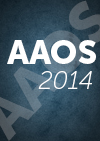
AAOS: Pinless computer navigation system more accurate than conventional technique in TKA

AAOS: Pinless computer navigation system more accurate than conventional technique in TKA
Pinless Navigation Versus Conventional Total Knee Arthroplasty: A Double Blinded Randomized Controlled Trial
CONFERENCE ACE REPORTS
This ACE Report is a summary of a conference presentation or abstract. The information provided has limited the ability to provide an accurate assessment of the risk of bias or the overall quality. Please interpret the results with caution as trials may be in progress and select results may have been presented.
Synopsis
100 patients scheduled to undergo primary total knee arthroplasty (TKA) were randomized to undergo the procedure using either a new pinless computer navigation system or a conventional technique. The purpose of this study was to examine the accuracy of this new system for implant alignment. Results indicated that there was a significant difference in favour of the new pinless computer navigation s...
To view the full content, login to your account,
or start your 30-day FREE Trial today.
FREE TRIAL
LOGIN
Forgot Password?
Explore some of our unlocked ACE Reports below!

Learn about our AI Driven
High Impact Search Feature
Our AI driven High Impact metric calculates the impact an article will have by considering both the publishing journal and the content of the article itself. Built using the latest advances in natural language processing, OE High Impact predicts an article’s future number of citations better than impact factor alone.
Continue



 LOGIN
LOGIN

Join the Conversation
Please Login or Join to leave comments.